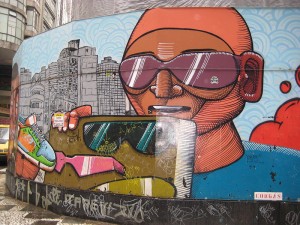Art Movements of 2000s: Street art
Street art
is any art developed in public spaces — that is, “in the streets” — though the term usually refers to unsanctioned art, as opposed to government sponsored initiatives. The term can include traditional graffiti artwork, stencil graffiti, sticker art, wheatpasting and street poster art, video projection, art intervention, guerrilla art, flash mobbing and street installations. Typically, the term street art or the more specificpost-graffiti is used to distinguish contemporary public-space artwork from territorial graffiti, vandalism, and corporate art.

A street art mural in São Paulo, Brazil
Artists have challenged art by situating it in non-art contexts. ‘Street’ artists do not aspire to change the definition of an artwork, but rather to question the existing environment with its own language. They attempt to have their work communicate with everyday people about socially relevant themes in ways that are informed by esthetic values without being imprisoned by them. John Fekner defines street art as “all art on the street that’s not graffiti.”
The motivations and objectives that drive street artists are as varied as the artists themselves. There is a strong current of activism andsubversion in urban art. Street art can be a powerful platform for reaching the public, and frequent themes include adbusting, subvertising and other culture jamming, the abolishment of private property and reclaiming the streets. Other street artists simply see urban space as an untapped format for personal artwork, while others may appreciate the challenges and risks that are associated with installing illicit artwork in public places. However the universal theme in most, if not all street art, is that adapting visual artwork into a format which utilizes public space, allows artists who may otherwise feel disenfranchised, to reach a much broader audience than traditional artwork and galleries normally allow.
Techniques
Whereas traditional graffiti artists have primarily used free-hand aerosol paints to produce their works, “street art” encompasses many other media and techniques, including: LED art, mosaic tiling, murals, stencil art, sticker art, street installations, wheatpasting, woodblocking, video projection, and yarn bombing.
Traditional graffiti also has increasingly been adopted as a method for advertising; its trajectory has even in some cases led its artists to work on contract as graphic artists for corporations. Nevertheless, street art is a label often adopted by artists who wish to keep their work unaffiliated and strongly political. Street artists are those whose work is still largely done without official approval in public areas.
For these reasons street art is sometimes considered “post-graffiti” and sometimes even “neo-graffiti.” Street art can be found around the world and street artists often travel to other countries foreign to them so they can spread their designs.
Street artists
Street artists such as Above, Jef Aérosol, Banksy, Mat Benote, BLU, Cartrain, Ces53, Dan Witz, D*Face, Ellis Gallagher, Tod Hanson, Neck Face, Os Gemeos, Swoon, Twist, and 108, have earned international attention for their work and have shown their works in museums or galleries as well as on the street. It is also not uncommon for street artists to achieve commercial success (e.g., Ash, Shepard Fairey, Ron English, Faile, Mr. Brainwash and WK Interact), doing graphics for other companies or starting their own merchandising lines. Other pioneers of street art who have completely discontinued street art (e.g., Richard Hambleton and members of AVANT) have also successfully pursued their contemporary art careers in galleries and museums.
In 1981, Washington Project for the Arts held an exhibition entitled Street Art, which included John Fekner, Fab Five Freddy and Lee Quinonesworking directly on the streets. Fekner, a pioneer in urban art, is included in Cedar Lewisohn’s book Street Art: The Graffiti Revolution, which accompanied the 2008 Street Art exhibition at the Tate Modern in England, of which Lewisohn was the curator.
The 1990 book Soho Walls – Beyond Graffiti by David Robinson documents the paradigm shift in New York from the text-based precedents established by graffiti artists toward art in the streets such as the shadow figures by Richard Hambleton and the group of five young New York artists working collectively under the moniker AVANT.
Source: en.wikipedia.org.com


This Post Has 0 Comments